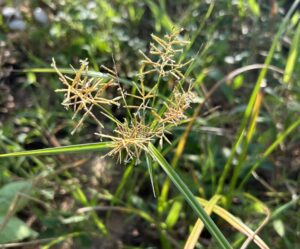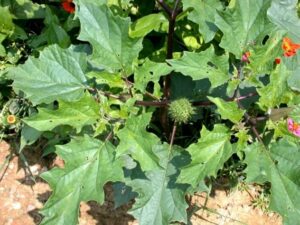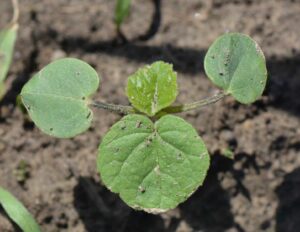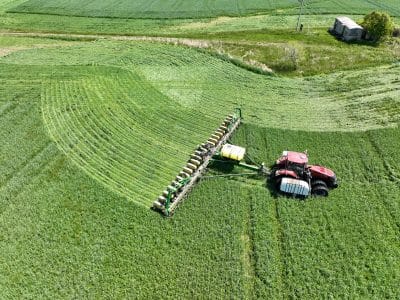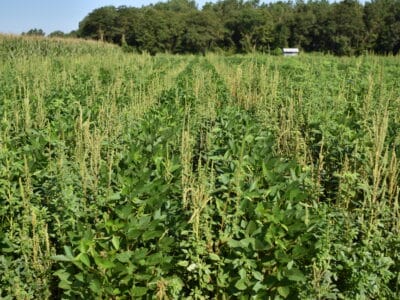Lolium perenne L. ssp. multiflorum (Lam.) Husnot.
Also known as: annual ryegrass, annual rye
The nomenclature surrounding ryegrass is fuzzy. In the United States (US), annual ryegrass/Italian ryegrass are listed as Lolium perenne L. ssp. multiflorum (Lam.) Husnot. In Australia, New Zealand, and a few other countries, L. rigidum, which is known as rigid ryegrass, is also recognized as annual ryegrass. Italian ryegrass genotypes have different uses (e.g., as a forage, turf, cover crop species), but they can also be present as a serious weed problem in winter cereal crops such as wheat and barley. In addition, perennial ryegrass (L. perenne L. ssp. perenne) shares similar genetics with Italian or annual ryegrass (L. multiflorum) and looks similarly. They easily hybridize and create a wide range of plants with similar external features which include the traits of both species and create difficulty in terms of both identification and management. Exacerbating the problem, festuca can also cross with these two species and produces a two- or three- species complex under natural conditions, making specific management practices based on a species difficult. Therefore, when intentionally planting ryegrass species, it’s better to know what you are buying.
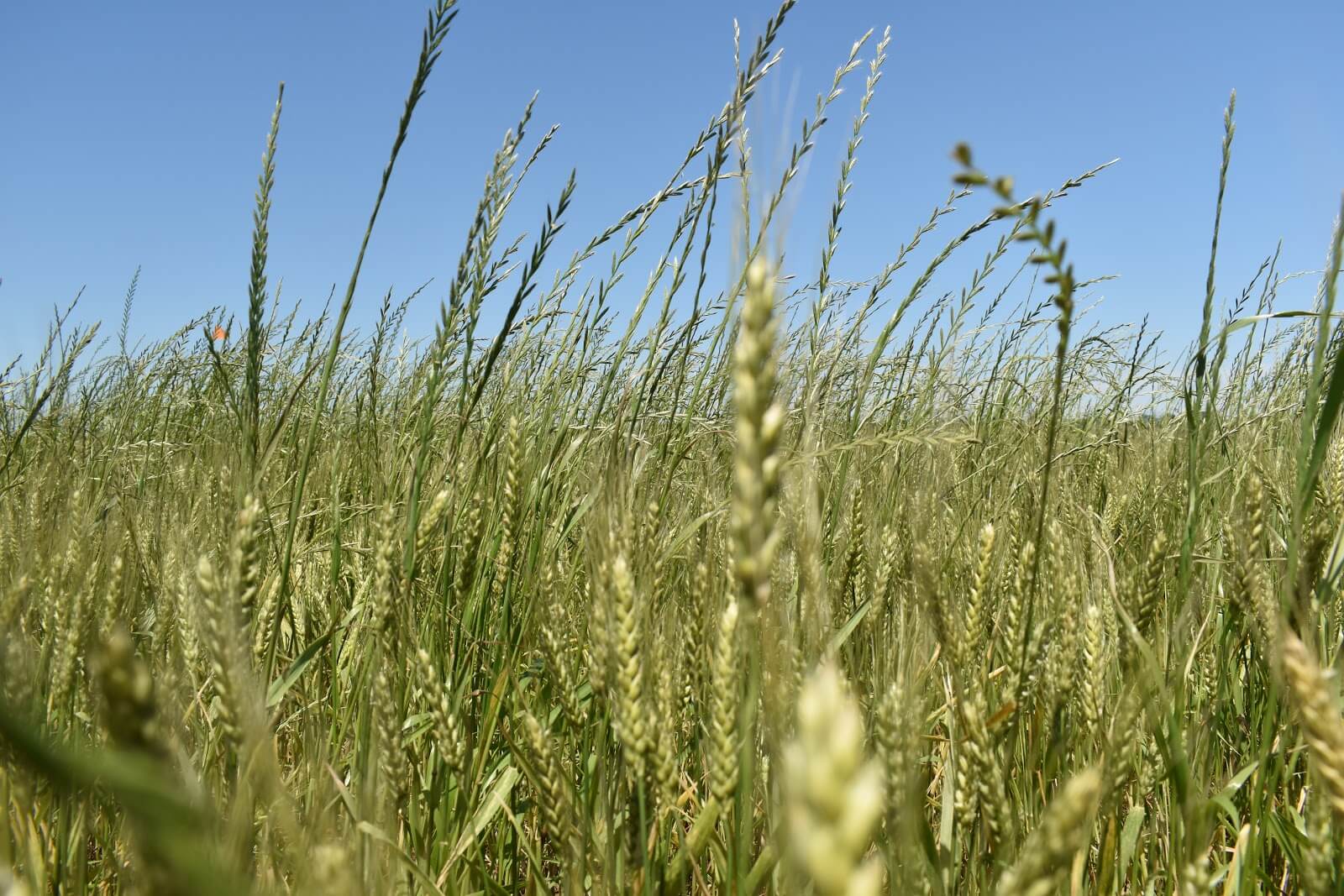
Biology
Italian ryegrass is a winter annual weed species found throughout the US infesting small grain production, where it can cause yield losses in excess of 50%, reaching as high as 100% in severely infested fields. In many parts of the south-central US, a second flush of ryegrass seedlings emerges during the spring, which creates difficulties for management. Ryegrass populations have different degrees of seed dormancy and thus show a staggered but continuous emergence pattern until the shade from the cash crop completely suppresses their emergence. Italian ryegrass exhibits high levels of genetic diversity, which allows for adaptation to a wide range of soil textures and environmental conditions. Because it is an annual weed, it must regenerate from seed each year. Seeds can germinate across a wide range of temperatures, but soil temperatures of approximately 65-70 degrees F are considered optimal for germination in the south-central US. Seedlings show rapid growth potential, with the production of multiple tillers. Italian ryegrass tends to dominate conservation tillage systems where soil disturbance is limited.
Italian ryegrass often displays high levels of seed shattering. Research conducted at Washington State University found that only 58% of weed seeds are retained at wheat harvest. Results from Texas also confirm these findings. However, the seed retained on the plants at harvest can still be substantial. In Virginia, Italian ryegrass has been documented to retain 110 to 293 lb. of seed per acre at wheat harvest, well exceeding recommended seeding rates of about 25 lb. per acre for the species when used as a forage. Seedbank persistence is not well researched, but forage systems requiring annual re-seeding suggest that seeds are relatively short-lived. Italian ryegrass is a wind-pollinated species, capable of dispersing pollen over long distances. Though studies are limited, it is likely that pollen- dispersal can spread herbicide resistance across ryegrass populations in an agricultural landscape.
What is the lifecycle of an Italian ryegrass like?
Seeds start germinating in fall followed by a rapid growth rate when the temperature is moderately low. During winter, the growth slows down and reaccelerates in spring. Flowering occurs during May to July depending on the climatic conditions and produces a large quantity of seeds which shatter substantially during maturity. Usually the plants die after seed maturity and do not develop a sizable seedbank due to short seed dormancy period, which ensures its resurgence in fall.
Example graph:

Herbicide Resistance
Italian ryegrass is the most successful weed species in terms of herbicide resistance evolution and is currently reported to exhibit resistance to eight herbicide modes of action. The extensive level of diverse traits present in this weed gives it an edge for surviving herbicide applications and helps to explain the ease and rapidity with which the species develops herbicide resistance.

Contact your local extension office for details about resistance in your area and management options.
*Herbicide names listed are representative products that contain specific active ingredients. Last updated on: 7-10-2020
Integrated Weed Management Strategies
Italian Ryegrass Management Integrating Multi-tactic Plan
Cultural Tactics such as crop rotation and narrow row spacing can reduce Italian ryegrass populations. Crop rotation out of continuous wheat will shift typical production practices like the timing of planting, tillage, and herbicide applications and allow for more diverse management tactics. Italian ryegrass is intolerant to shade so narrowing row spacing allows crops to canopy quickly and slows down the growth of Italian ryegrass.
Tillage, herbicide application, and harvest weed seed control are other key tactics to prevent Italian ryegrass from setting seed. Crop rotation out of continuous wheat, adding summer annual crop with an effective burndown application is a potential alternative management strategy. Till or spray early enough in spring so the Italian ryegrass plants do not set seed.
Cover Crops: If Italian ryegrass infests your cover crops, make sure the cover crops are terminated before the weeds set seeds. Cover crops are not the best option for suppression of Italian ryegrass compared to other summer annual weeds. If ryegrasses are a weed of concern in your cropping system, consider planting cover crops other than annual ryegrass and buy clean cover crop seed.
Mechanical: Pulling, cutting, or disking – the traditional mechanical management methods – do not provide sufficient control since ryegrass is highly tolerant of them. However, small patches can be controlled by hand-weeding, which is not a viable option for large scale production scenarios. Trampling, mowing, or grazing are also equally ineffective since ryegrass can easily regrow with any available soil moisture. Occasional deep tillage may stop ryegrass seed germination by burying them at greater depth, but takes up to seven years to achieve that.
Harvest weed seed control (HWSC) tactics developed in Australia, another country where ryegrass is the major weed problem in wheat, promises great potential to reduce ryegrass seedbank inputs and subsequent field infestations. HWSC aims to destroy the weed seeds during crop harvest so that the soil seedbank declines rapidly, gradually drawing down the weed seedbank and making it easier to manage with available herbicide programs. High weed seed retention is a prerequisite for successful HWSC. Currently, three types of HWSC are in use in Australia and are being tested for their potential across the US. The first type, narrow-windrow burning, collects the weed seeds and cash crop chaff from the harvester and deposits it in narrow lines in the field, which are then burnt. The burning is of concern from an environmental pollution and uncontrolled fire risk standpoint. To avoid such problems, chaff lining involves collecting the chaff fraction separately from the straw in a similar way, then the seeds rot or germinate and then die due to poor seed-soil contact in the windrows. The latest development is the impact mill technology, which has been designed to collect the weed seeds separately from the chaff and grind them for complete destruction using high speed impact mills at the back of the combine. See our video, which details a 3-year study conducted in Texas and Arkansas showing that HWSC (narrow-windrow burning), when combined with the best herbicide program existing in that region, achieves maximum ryegrass control and reduces the soil seedbank significantly.
Chemical control remains the most-used tool to combat Italian ryegrass. However, as previously noted, Italian ryegrass resistance has limited the availability of key herbicides.
Chemical control of Italian ryegrass in small grains has often relied on Group 2 herbicides, such as mesosulfuron or pyroxsulum (Osprey or PowerFlex) and Group 1 (Axial XL, pinoxaden); where resistance is widespread pyroxasulfone (Anthem Flexx or Zidua) is commonly used. Pyroxasulfone needs to be applied prior to Italian ryegrass emergence since it will not control emerged plants.
Though glyphosate resistance has been reported in seven states, it is still used heavily as a burndown herbicide to control Italian ryegrass prior to planting summer crops. Controlling glyphosate-susceptible Italian ryegrass in the spring prior to planting corn, cotton, or soybean is challenging due to its vigorous growth and potential antagonism when glyphosate is mixed with other herbicides. Paraquat is utilized extensively as a burndown in the southern states for Italian ryegrass.
In broadleaf crops, postemergence grass herbicides (such as clethodim and sethoxydim) can be used as part of a burndown program or as a postemergence application. Most of the Group 15 herbicides (such as Dual Magnum, Zidua) will provide residual control, yet their utility is limited since most Italian ryegrass populations will have emerged at time of summer crop planting.
Refer to your local extension’s weed management guide for effective options.
There are no reliable microbial-based biological control options for Italian ryegrass. Though many fungi are reported to infect ryegrass seedheads, they do not sufficiently and consistently reduce seed production enough to represent a management option. However, research conducted in Texas showed that delaying field disking after wheat harvest can increase ryegrass seed loss from the soil surface by exposing them to ants, beetles, birds and other animals that consume them.
For a deep dive into the integrated weed management options for managing herbicide-resistant Italian ryegrass in the Pacific Northwest, see this PNW Extension Publication.
Similar Weed Species
Rigid ryegrass (L. rigidum) and perennial ryegrass (L. perenne) are the other two closely related species of Italian ryegrass. As the Italian and perennial are the two most commonly occurring species in the States and can cross easily to each other giving rise to a diverse range of phenotypes, here is a comparison table based on a few key identifying traits.
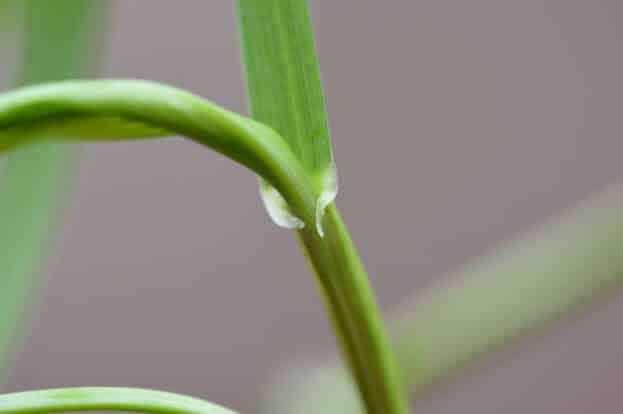
Characteristics
L. perenne or Perennial Type
L. multiflorum or Annual Type
Growth habit
Mostly spreading type with relatively less vigorous growth. Plants have a bunchy form, with numerous long, narrow, stiff leaves near the base of the plant.
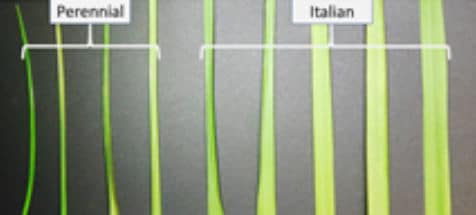
Mostly erect to semi-erect type with highly vigorous growth. Plants look straight and less bunchy with wider and fewer leaves.
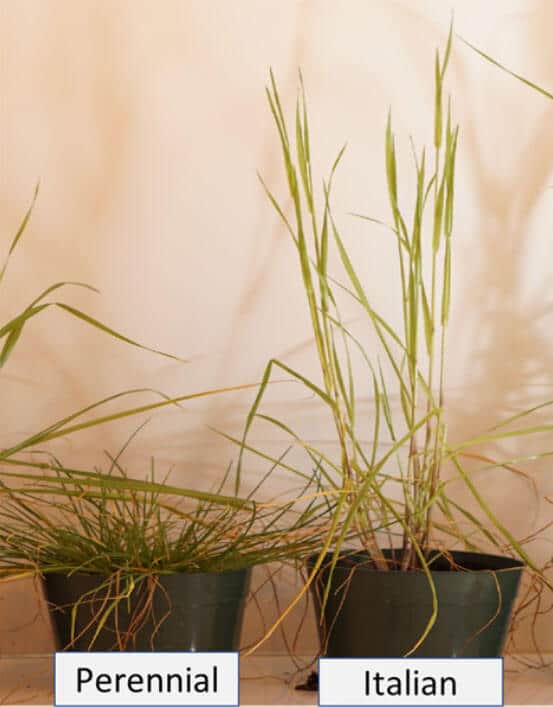
Auricle: It is a small finger-like projection from the base of the leaf where leaf sheath attaches to the stem.
Very short and they do not clasp the stem.
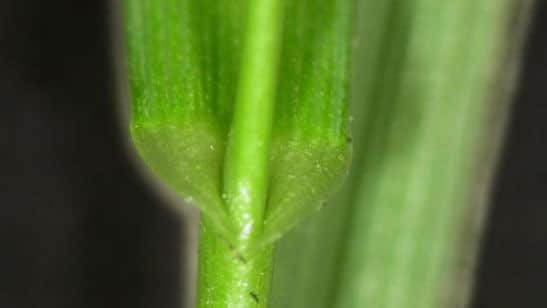
The auricles are long and clasp around the stem.

Seed and seed awn: Awn is a hair- or bristle-like appendage on top of the seed.
Smaller seeds, mostly 6 to 10 flowers per spikelet. Awn is usually absent.
Larger seeds, 10 to 20 flowers per spikelet. Awn is usually present.
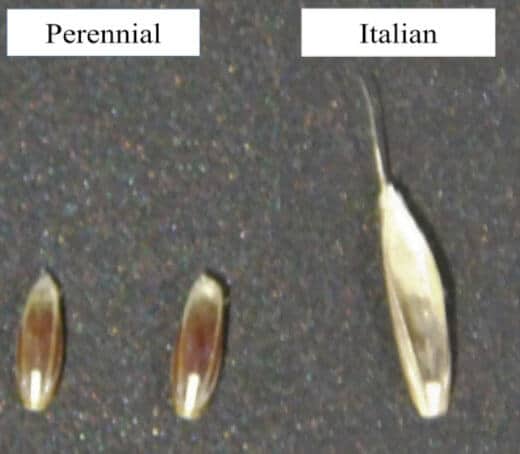
For more information on Italian ryegrass management, visit:
https://growiwm.org/factsheets/italian-ryegrass-management-in-soybeans/
Authors
- Muthukumar Bagavathiannan
- Aniruddha Maity
Editors
- Victoria Ackroyd
- Claudio Rubione
- Mark VanGessel
- Michael Flessner
Reviewed by
- Misha Manuchehri, Oklahoma State University
- Jason Bond, Mississippi State University
Resources
Galla M, Italian ryegrass management in Sacramento Vallley wheat https://ucanr.edu/blogs/blogcore/postdetail.cfm?postnum=26333 Accessed: Aug 2, 2021
Heap I (2019) The International Survey of Herbicide Resistant Weeds. www.weedscience.org/ Accessed: August 29, 2021
Hefty B, Hefty D, Weed of the week: Italian ryegrass https://youtu.be/n5HFCevOAAI?si=Rc7iJ_spjZzyMhX3. Accessed: Aug 2, 2021
Take action on weeds: Italian ryegrass https://growiwm.org/factsheets/italian-ryegrass-management-in-soybeans/ Accessed August 2, 2021
Citations
Beam SC, Mirsky SB, Cahoon C, Haak D (2019) Harvest weed seed control of Italian ryegrass [Lolium perenne L. ssp. multiflorum (Lam.) Husnot], common ragweed (Ambrosia artemisiifolia L.), and Palmer amaranth (Amaranthus palmeri S. Watson), Weed Technology: 24 doi.org/10.1017/wet.2019.46
Bararpour MT, Norsworthy JK, Burgos NR, Korres NE, Gbur EE (2019) Identification and biological characteristics of ryegrass (Lolium spp.) accessions in Arkansas. Weed Technology 33:627-632 doi.org/10.1017/wsc.2016.28
Brunnharo CA, Bradley DH, (2018) Multiple herbicide–resistant Italian ryegrass [Lolium perenne L. spp. multiflorum (Lam.) Husnot] in California perennial crops: characterization, mechanism of resistance, and chemical management. Weed Science 66:696-701 doi.org/10.1017/wsc.2018.50
Liu M, Hulting A, Mallory-Smith C (2017) Characterization of multiple herbicide-resistant Italian ryegrass (Lolium perenne ssp multiflorum) populations from winter wheat fields in Oregon. Weed Science 64:331-338 doi.org/10.1614/WS-D-15-00147.1
Lyon DJ, Huggins DR, Spring JF (2016) Windrow burning eliminates Italian ryegrass (Lolium perenne ssp. multiflorum) seed viability. Weed Technology 30: 279-283 doi.org/10.1614/WT-D-15-00118.1
Mahajan G, McKenzie K, Chauhan BS (2019) Influence of row spacing and cultivar selection on annual ryegrass (Lolium rigidum) control and grain yield in chickpea (Cicer arietinum). Crop & Pasture Science 70:140-146 doi.org/10.1071/CP18436
Walsh MJ, Broster JC, Schwartz-Lazaro LM, Norsworthy JK, Davis AS, Tidemann BD, Beckie HJ, Lyon DJ, Soni N, Neve P, Bagavathiannan MV (2018) Opportunities and challenges for harvest weed seed control in global cropping systems. Pest Management Science 74:2235-2245 doi.org/10.1002/ps.4802


